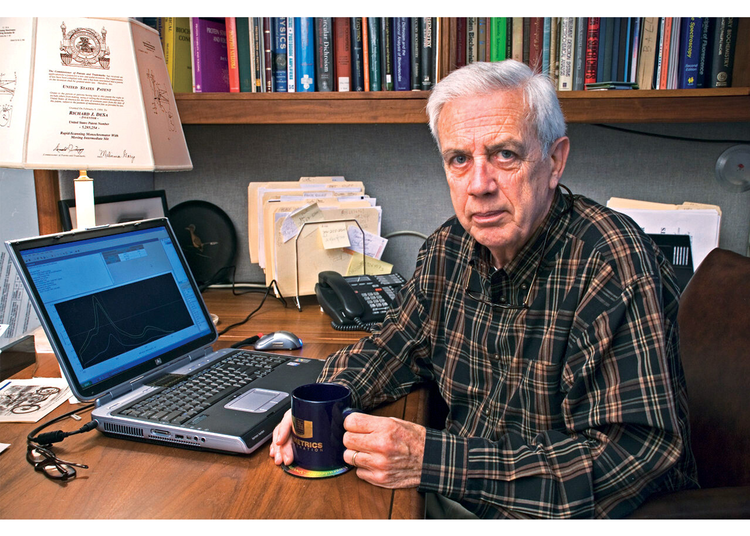Excitement About Uv/vis/nir
Wiki Article
Getting My Uv/vis/nir To Work
Table of Contents7 Easy Facts About Uv/vis ExplainedThe Best Strategy To Use For Circularly Polarized LuminescenceExcitement About Uv/vis/nirHow Spectrophotometers can Save You Time, Stress, and Money.The Ultimate Guide To Uv/vis/nir

Spectrophotometry is most commonly applied to ultraviolet, noticeable, and infrared radiation, modern spectrophotometers can interrogate broad swaths of the electromagnetic spectrum, including x-ray, ultraviolet, visible, infrared, and/or microwave wavelengths. Spectrophotometry is a tool that depends upon the quantitative analysis of particles depending upon just how much light is soaked up by colored compounds.
Uv/vis for Dummies
A spectrophotometer is commonly used for the measurement of transmittance or reflectance of options, transparent or nontransparent solids, such as refined glass, or gases. Many biochemicals are colored, as in, they soak up visible light and for that reason can be measured by colorimetric procedures, even colorless biochemicals can frequently be converted to colored substances suitable for chromogenic color-forming responses to yield compounds suitable for colorimetric analysis.: 65 Nevertheless, they can also be designed to determine the diffusivity on any of the noted light ranges that normally cover around 2002500 nm using different controls and calibrations.An example of an experiment in which spectrophotometry is used is the decision of the equilibrium constant of a service. A specific chemical reaction within an option might occur in a forward and reverse instructions, where reactants form products and products break down into reactants. Eventually, this chemical reaction will reach a point of balance called an equilibrium point.
Some Known Incorrect Statements About Circular Dichroism
The quantity of light that goes through the solution is indicative of the concentration of specific chemicals that do not enable light to go through. The absorption of light is due to the interaction of light with the electronic and vibrational modes of molecules. Each type of molecule has an individual set of energy levels associated with the makeup of its chemical bonds and nuclei and thus will take in light of particular wavelengths, or energies, leading to special spectral properties.
Making use of spectrophotometers spans numerous scientific fields, such as physics, materials science, chemistry, biochemistry. UV/Vis, chemical engineering, and molecular biology. They are commonly used in many industries consisting of semiconductors, laser and optical manufacturing, printing and forensic evaluation, as well as in laboratories for the study of chemical compounds. Spectrophotometry is frequently utilized in measurements of enzyme activities, decisions of protein concentrations, decisions of enzymatic kinetic constants, and measurements of ligand binding reactions.: 65 Eventually, a spectrophotometer is able to figure out, depending on the control or calibration, what substances are present in a target and precisely how much through computations of observed wavelengths.
This would come as an option to the formerly developed spectrophotometers which were unable to absorb the ultraviolet correctly.
Top Guidelines Of Uv/vis
It would be discovered that this did not give acceptable outcomes, for that reason in Design B, there was a shift from a glass to a quartz prism which allowed for better absorbance results - circular dichroism (https://lwccareers.lindsey.edu/profiles/4273853-julie-ann-desa-lorenz). From there, Model C was born with a change to the wavelength resolution which ended up having three units of it producedIt was produced from 1941 to 1976 where the cost for it in 1941 was US$723 (far-UV devices were a choice at additional expense). In the words of Nobel chemistry laureate Bruce Merrifield, it was "probably the most essential instrument ever developed towards the advancement of bioscience." Once it ended up being stopped in 1976, Hewlett-Packard developed the very first commercially readily available diode-array spectrophotometer in 1979 called the HP 8450A. It irradiates the sample with polychromatic light which the sample takes in depending upon its residential or commercial properties. Then it is go to website transferred back by grating the photodiode array which discovers the wavelength region of the spectrum. Considering that then, the creation and implementation of spectrophotometry devices has increased exceptionally and has actually become one of the most innovative instruments of our time.

Not known Facts About Uv/vis
Historically, spectrophotometers use a monochromator consisting of a diffraction grating to produce the analytical spectrum. The grating can either be movable or repaired. If a single detector, such as a photomultiplier tube or photodiode is utilized, the grating can be scanned step-by-step (scanning spectrophotometer) so that the detector can measure the light strength at each wavelength (which will represent each "step").In such systems, the grating is repaired and the intensity of each wavelength of light is determined by a various detector in the range. In addition, most modern-day mid-infrared spectrophotometers use a Fourier change strategy to acquire the spectral details - https://www.4shared.com/u/FvsNFVfH/julieanndesalorenz30606.html. This method is called Fourier transform infrared spectroscopy. When making transmission measurements, the spectrophotometer quantitatively compares the portion of light that goes through a referral solution and a test option, then electronically compares the intensities of the two signals and calculates the percentage of transmission of the sample compared to the recommendation requirement.

Report this wiki page